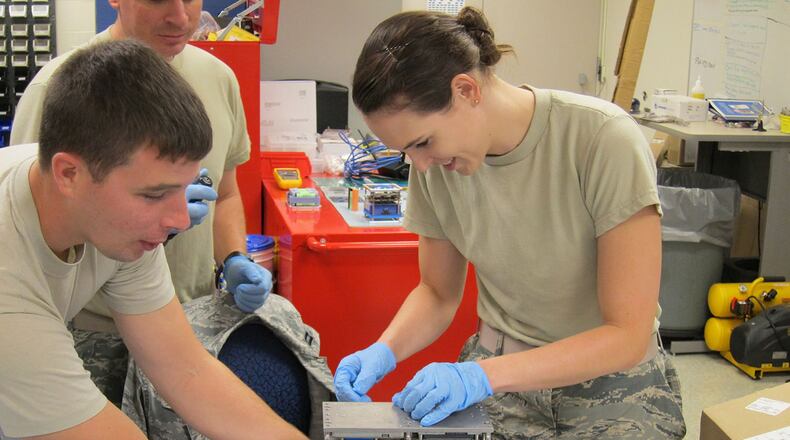“The partnership between NASIC and AFIT helps establish a mindset of collaboration and teamwork that is critical to professional development of new personnel, as well as the advancement of the mission of Wright-Patterson Air Force Base,” Bettinger said.
NASIC’s Space, Missiles and Forces Intelligence Group was the first to participate in this exchange agreement and sent 12 of its newly hired analysts to AFIT to work on space- and missile-related projects under the sponsorship of AFIT’s Department of Aeronautics and Astronautics. NASIC’s Counterspace Analysis Squadron, Ballistic Missiles Analysis Squadron and the Space Analysis Squadron are all participating in the program.
One such analyst is Broden Kelly of the Counterspace Analysis Squadron, and a recent computer science engineering graduate from the Ohio State University. In February 2017, Broden joined NASIC and immediately went to work at AFIT to support Col. Dane Fuller, Center for Space Research and Assurance director.
In this capacity, Kelly is helping determine the usability of space system design software for use in graduate-level coursework and thesis research. He is also supporting AFIT’s small satellite design efforts by helping to develop a payload that will fly on the U.S. Air Force Academy’s FalconSat-8 to provide star tracking capability.
“I am grateful for the opportunity to utilize my degree in a meaningful manner at AFIT while waiting for my security clearance at NASIC,” Broden said. “Working at AFIT has taught me the importance of overcoming hurdles pertaining to the software of space-based systems. Also, I think it’s pretty awesome that something I’ve helped to create will soon be orbiting the earth with AFIT’s payload for FalconSat-8.”
Other research projects have included computer program scripting, telescope observation automation and other space-related efforts. Many of these efforts have direct application to the analyst’s job once he or she receives his or her security clearance and begins work at NASIC.
“The relationship with AFIT allows our new hires to gain valuable experience relevant to their job and they are able to make meaningful contributions to academic research projects,” Lassie Wilson, NASIC flight chief noted. “It also allows us to take advantage of the resources at AFIT to address common questions of research, therefore benefiting both NASIC and AFIT.”
Periodic showcase presentations are scheduled with squadron leadership to provide updates on the progress of the analysts’ efforts. These efforts not only highlight the technical aspects of their research at AFIT, but also provide the analysts with an opportunity to further develop their soft skills, such as public speaking and developing presentations.
While at AFIT, analysts can also take advantage of free tuition towards obtaining a Master’s Degree.
Plans are being made to continue with this joint effort for the next five years and expand it to include other NASIC units.
“We are very, very pleased with the partnership we have with NASIC,” Fuller said. “These new hires are making outstanding contributions to education and research at AFIT.”
About the Author
